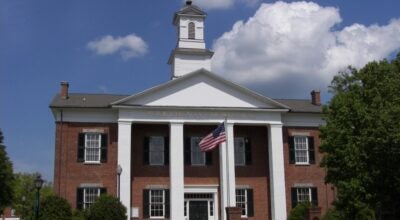Block House founder, Carter Brown, ‘put Tryon on the map’
Published 4:40 pm Friday, April 16, 2010
Carter Brown arrived in Tryon in 1917 and that was the time that the horse became important to Tryon for reasons other than transportation.
Local historian and former Tryon Riding and Hunt Club President Colonel Charles C. Ross, U.S. Army (Retd.), better known as “Chuck,” gave a history of the horse in Polk County, the history of the Tryon Riding and Hunt Club and of rBrowns time in Tryon to the Polk County Historical Association last week.
Ross spoke in front of about 50 local residents.
Ross said due to the efforts of one man, the year 1917 marked the beginnings of the modern era of the horse in Tryon.
Brown came to Tryon from Michigan and opened the Pine Crest Inn, a “hostelry where affluent northerners came to spend their winters on horseback or at the golf course,” Ross said.
“Carter Brown was not the only horseman of that time; but, he was the man who put Tryon on the map as a horse center,” said Ross.
Following World War I, Brown founded the Tryon Riding and Hunt Club in 1925 and served as the clubs first president. He started a fox hunt in 1926, was with the Tryon Hounds for many years, was the “guiding light” of the Tryon Horse Show and the “father” of the Block House Steeplechase.
The Tryon Horse Show was founded in 1929 and the first Steeplechase was held at Harmon Field in 1934 with a variety of stout fences, timber and brush and even a water jump, Ross said. After three years, the race was discontinued and after World War II, the first Blockhouse Steeplechase was held in 1947 at the Block House site.
The “big race” at that time was run for a purse of $500. By comparison, Ross said, the race today carries a reward of $25,000 and the total purses for four jump races and one or two flat races is $67,000.
Ross also spoke of the history of the horse in the Polk County area that most probably dates back after the landing of the Spanish Explorer, Hernan de Soto, on the coast of Florida in 1539 and his subsequent march inland through Florida, Georgia, North and South Carolina.
He also spoke of other notable equestrian events in Tryon throughout its history, including fox hunts.
The Tryon Horse Show, Ross said, was an A-rated American Horse Show Association event and was held on Wednesdays. Many of the riders were local and there was a huge barbeque, free for all landowners who allowed the Tryon Hounds to hunt their property, according to Ross.
“The event was so popular that the schools were let out and most businesses closed for the afternoon,” Ross said.
For most of the Tryon Horse Show days, it was held at Harmon Field and in recent years has moved to the Foothills Equestrian Nature Center (FENCE), however some smaller shows are still held at Harmon Field.
The Tryon Riding and Hunt Club also used to hold a junior horse show at Mr. and Mrs. Willis Kuhns Cotton Patch.
The Cotton Patch also gained fame as the training site for the U.S. Equestrian Team in preparation for the 1956 Olympics, Ross said. He named equestrian greats such as coaches Bert de Nemethy and General Tupper Cole and riders Billie Steinkraus, Hugh Wiley, Frank Chapot, George Morris and Jack Burton who trained here.
Ross spoke of the function of the Tryon Riding and Hunt Club and said it was the “first entrepreneur.” The club ran the horse show and the Steeplechase, including obtaining sponsors for the purses and the payments of advertising in the newspapers for the events.
The first two winners of the Block House were Austin Browns “Bluish,” ridden by the owner. Austin Brown, one of Carter Browns sons, also won the fourth Block House. The first North Carolina Timber Cup was won by Carter Browns other son, Carter Wilkie, riding his horse, “Dwight,” Ross said.
Ross said the Tryon Riding and Hunt Club instituted the form of eventing in Tryon and still runs two horse trials annually. With the plethora of horse events in Polk County, Ross said, the Tryon Riding and Hunt Club can no longer organize all the events, but has encouraged such clubs as the Carolina Carriage Club, the Blue Ridge Hunter Jumper Association, Foothills Riding Club, River Valley Pony Club and the fox hunts to hold shows, rallies, hunter pace events and many others.
The Tryon Riding and Hunt Club also had much to do with the birth of another major horse organization, FENCE, Ross said.
Ross also spoke of the Tryon Riding and Hunt Clubs newly acquired property of the Green Creek Equestrian Park, thanks to the generous 97-acre donation from Mr. and Mrs. Roger Smith.
“TRHC is now investing some $8 million in construction of a new facility, to include a steeplechase course, a Grand Prix field, four other hunter-jumper rings, stabling for over 500 horses and all the other necessities for a first-rate equestrian park,” said Ross.
The Block House Steeplechase, with a target date of moving the race from FENCE to the new park for 2012-2013, will be lengthened to a one-mile course and more than double in width.
“Accordingly, the horse is all important in Polk County,” Ross ended his talk. “Horses provide sport, pleasure, entertainment, business, and the good country living. It can be said that horses are a way of life in our pleasant community here in rural North Carolina.”
&bsp;





